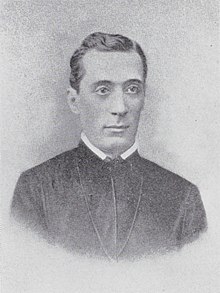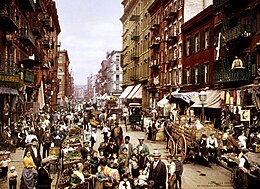
Edmund Aloysius Walsh was an American Roman Catholic priest of the Society of Jesus and career diplomat from South Boston, Massachusetts. He was also an author, professor of geopolitics and founder of the Georgetown University School of Foreign Service, the first school for international affairs ever founded in the United States. He founded the school in 1919–six years before the U.S. Foreign Service itself even existed–and served as its first regent.

John Bapst was a Swiss Jesuit missionary and educator who became the first president of Boston College.
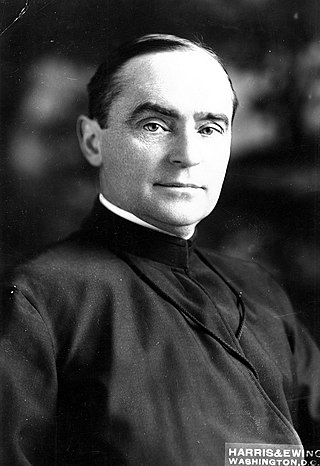
Alphonsus J. Donlon was an American Catholic priest and Jesuit who spent his career in priestly ministry and academia, including as president of Georgetown University from 1912 to 1918. Born in Albany, New York, he garnered a reputation as a good student and an exceptional collegiate athlete. As a professor, he went on to lead Georgetown University's sports program, which enjoyed great success. As a result, he became known as the "father of Georgetown athletics." He served as a professor of various sciences at Georgetown University and at Woodstock College, and as president of the former, he oversaw the removal of Georgetown Preparatory School from the university to a separate campus, and proposed the creation of the School of Foreign Service. For a significant portion of his career, he also served as a chaplain to Georgetown Visitation Monastery. In his later years, he engaged in pastoral work at St. Francis Xavier Church in New York City and taught at Fordham University.

Charles William Lyons was an American Catholic priest who became the only Jesuit and likely the only educator in the United States to have served as the president of four colleges. Born in Boston, Massachusetts, he attended the local public schools before entering the wool industry. He abandoned his career in industry to enter the Society of Jesus. While a novice in Maryland, he suffered a nervous breakdown and was sent to Georgetown University as prefect. He then resumed his studies at Woodstock College, teaching intermittently at Gonzaga College in Washington, D.C. and Loyola College in Baltimore. After his ordination, he became a professor at St. Francis Xavier College in New York City and at Boston College.
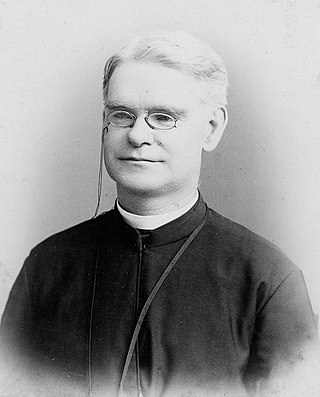
James Aloysius Doonan was an American Catholic priest and Jesuit, who was the president of Georgetown University from 1882 to 1888. During that time he oversaw the naming of Gaston Hall and the construction of a new building for the School of Medicine. Doonan also acquired two historic cannons that were placed in front of Healy Hall. His presidency was financially successful, with a reduction in the university's burdensome debt that had accrued during the construction of Healy Hall.
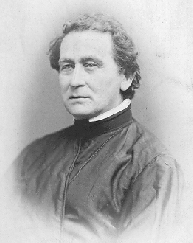
Anthony Francis Ciampi was an Italian-American priest of the Catholic Church and member of the Society of Jesus.

Thomas Ignatius Gasson was an American Catholic priest and Jesuit. Born in England, he emigrated to the United States at the age of 13, and was taken under the care of two Catholic women in Philadelphia, which led to his conversion to Catholicism soon thereafter. He entered the Society of Jesus in 1875, and studied theology at the University of Innsbruck in Austria, where he was ordained a priest. Upon his return to the United States, he became a professor at Boston College, before being named President of Boston College in 1907.
James A. Ward was an American Catholic priest and Jesuit. He taught for many years at Georgetown and at the novitiate in Frederick, Maryland, of which he twice served as rector. He then became the vice president of Georgetown and was influential in the early years of Loyola College in Maryland. From 1857 to 1860, he was the President of Saint Joseph's College. He spent his later years as socius (assistant) to the Jesuit provincial superior in New York City, and teaching.

William J. Devlin, S.J. was an American Catholic priest and Jesuit. Born in New York City, he spent many of his early years in Europe, where he was educated at Stonyhurst College in England. Devlin entered the Society of Jesus in Maryland in 1893, and studied at Woodstock College. He became a professor at Boston College in 1910, and eventually became the dean.
Francis Xavier Talbot was an American Catholic priest and Jesuit who was active in Catholic literary and publishing circles, and became the President of Loyola College in Maryland. Born in Philadelphia, he entered the Society of Jesus in 1906, and was educated at St. Andrew-on-Hudson and Woodstock College. He taught for several years in New York City and at Boston College, before entering publishing as the literary editor of America magazine in 1923, of which he became the editor-in-chief in 1936. While in this role, he was also active in founding and editing several academic journals, including Thought, and establishing various Catholic literary societies and book clubs. During World War II, he was chaplain to a Catholic organization that previewed movies for the National Legion of Decency. He also supported Franco's rule in Spain because of its support of Catholicism and opposition to communism; he also supported the US war effort. He was described as one of the early leaders of the revival of Catholic literature in the United States.
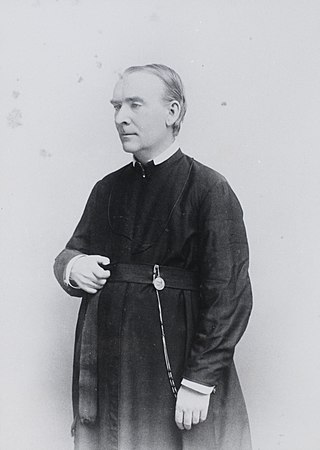
Edward Ignatius Devitt was a Canadian American priest, Jesuit, and historian of the American Catholic Church. Born in Saint John, New Brunswick, he moved with his family to Boston, Massachusetts, at a young age. He studied in public schools in the city before enrolling at the College of the Holy Cross. Devitt spent two years there, and then entered the Society of Jesus in 1859. He studied at the novitiate in Frederick, Maryland, and at the newly opened Woodstock College. He briefly taught at the Washington Seminary during his studies, and after graduating, was a professor for the next thirty years at Holy Cross, Woodstock, and Georgetown University.

Robert Wasson Brady was an American Catholic priest who led several Jesuit institutions in the United States. He served twice as the president of the College of the Holy Cross from 1867 to 1869 and from 1883 to 1887. He was also the second president of Boston College from 1869 to 1870 and the provincial superior of the Jesuits' Maryland Province from 1877 to 1882.

Robert James Fulton was an American Catholic priest and Jesuit who twice served as the president of Boston College, from 1870 to 1880 and 1888 to 1891. He was influential in the early years of Boston College, as he was in charge of all the school's academic affairs.

Jeremiah O'Connor was an American Catholic priest and Jesuit who served as the president of Boston College from 1880 to 1884. Born in Dublin, he emigrated to the United States as a boy and eventually studied at Saint Joseph's College. He entered the Society of Jesus in 1860. In his later years, he served in parochial roles in New York City.
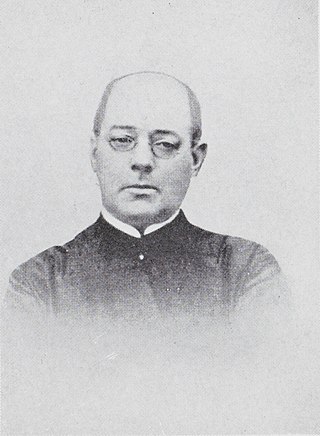
Edward Victor Boursaud was an American Catholic priest and Jesuit who was the president of Boston College from 1884 to 1887. Raised in New York City and France, he studied at Mount St. Mary's College in Maryland before entering the Society of Jesus in 1863. For the next 18 years, he studied and taught at Jesuit institutions, including Boston College, Georgetown College, and Woodstock College, as well as the novitiate in Frederick, Maryland. In 1881 and 1887, he served three-year terms in Italy as the assistant secretary to the Jesuit Superior General for the English-speaking world.

Timothy J. Brosnahan was an American Catholic priest and Jesuit who served as the president of Boston College from 1894 to 1898. Born in Virginia, he joined the Society of Jesus in 1872, and taught philosophy at Woodstock College, Georgetown University, and Boston College. After his presidency, he wrote a prominent article criticizing an article by Harvard University's president that deprecated Jesuit education. In his later years, he taught and wrote about ethics.

William F. Gannon was an American Catholic priest and Jesuit who was the president of Boston College from 1903 to 1907. Born in Cambridge, Massachusetts, he entered the Society of Jesus in 1876 and studied at Woodstock College. Before becoming president of Boston College, he then taught at Jesuit schools, including the College of the Holy Cross, Saint Peter's College, Fordham University, and Georgetown University. After his presidency, he engaged in pastoral work in New York City and Philadelphia.
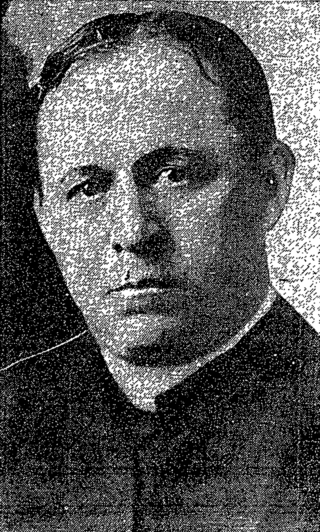
William J. Ennis was an American Catholic priest and Jesuit who was the president of Loyola College in Maryland from 1911 to 1918 and was the first vice principal of Loyola School in New York City. He entered the Society of Jesus in 1879 and during his Jesuit formation, studied at Woodstock College and taught at Georgetown University. In 1895, he became the prefect of studies at Georgetown.

William James McGarry was an American Catholic priest, Jesuit, and theologian who was the president of Boston College form 1937 to 1939. Born in Massachusetts, he received his Doctorate of Sacred Theology from Woodstock College and his Licentiate in Sacred Scripture from the Pontifical Biblical Institute. In 1930, McGarry became a professor of theology and various langauges at Weston College, ultimately becoming its prefect of studies in 1934.

William Lane Keleher was an American Catholic priest and Jesuit who was the president of Boston College from 1945 to 1951. During his tenure, the school oversaw rapid and significant growth in the number of students returning from World War II under the G.I. Bill. In the span of five years, enrollment increased from 236 to 7,526 students.
